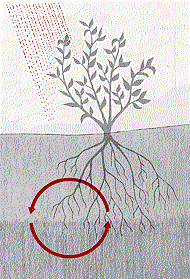
| Index to this page |

|
| A soil profile characteristic of the plains states. The rainfall is so light that minerals in the soil are seldom carried below the subsoil. |
Beneath this is the topsoil. This horizon is usually dark in color because of humus — partially decayed organic matter — which has been incorporated in it from above.
Humus gives the soil a loose texture that holds water and allows air to diffuse through it. Oxygen is essential to permit cellular respiration in plant roots, decay organisms, and other inhabitants of the soil.The situation is made worse by the lack of humus (the topsoil may be no thicker than 2 in. [= 5 cm]) and the high iron and aluminum content of most of these soils. Once exposed to the sun, these lateritic soils soon bake into a bricklike material that cannot be cultivated.
The most ancient (some might say primitive) way of working these soils is still the best:These regions receive 75–100 cm or more of precipitation each year. Enough water falls on the soil so that much of it passes down to the water table. As it does so, it carries minerals with it. Such soils tend to be acidic and of low and (if unattended) diminishing fertility. Only by regular fertilization and liming (to restore calcium and raise pH) can productive agriculture be carried out in them. In the U.S., the soils east of the Appalachian Mountains tend to be of this sort.

|
In the plains of North America, the annual rainfall is sufficiently low (~50 cm) that little or no rainfall percolates down to the water table. Calcium and other minerals are not carried below the reach of plant roots and so remain available for use. This keeps the pH and general fertility high.
Except to the extent that minerals are lost when crops are removed, the minerals simply recycle from subsoil to topsoil and back to the subsoil. The self-restoring fertility of the soils of the plains states accounts for this region being the "breadbasket" of the nation (and other countries as well).
The figure shows the cycling of minerals in grasslands soil. The grasses in undisturbed prairie are perennial; their extensive root systems help prevent soil erosion, and the return of the season's above-ground growth to the topsoil returns minerals and provides humus to it. These advantages are diminished when annual grasses such as wheat and corn are grown instead and removed in the harvest.
In the U. S., the situation is especially severed in the Great Basin states (Utah and Nevada) because water flowing down from the mountains — bearing its load of dissolved salts — cannot flow on to the ocean but simply flows out onto the valley floors and evaporates.
Large areas of formerly unproductive desert in the United States, Israel, and Egypt have been converted into fertile fields through irrigation.
| Link to an example (but 128K!) |
But irrigation is no panacea. Even the best irrigation water contains dissolved salts. If just enough water is applied to meet the needs of the crop, the salts are never carried deep in the soil. The high rate of evaporation found in these areas hastens the accumulation of salts in the upper layers of the soil. If uncorrected, the condition may become so severe that only salt-tolerant crops, like sugar beets, can be grown.
 Salts from evaporated irrigation water have accumulated to such a high level in this field in the desert biome of California that they stunt the growth of the cotton plants. (Courtesy of USDA, Soil Conservation Service.)
Salts from evaporated irrigation water have accumulated to such a high level in this field in the desert biome of California that they stunt the growth of the cotton plants. (Courtesy of USDA, Soil Conservation Service.)
The situation can be corrected by using enough additional irrigation water to flush the salts deep into the soil. Unfortunately, many desert soils are shallow and underlain by layers that are relatively impervious to water. Irrigation water that does not evaporate accumulates in the soil, and slowly the water table rises to the surface (if not at the point where the irrigation is applied, then farther down the valley). Soon fields become waterlogged with salty water and, unless steps are taken to drain the water away, productivity quickly declines.
Salt tolerance can be engineered into crops that normally are intolerant of saline soils. In 2001, scientists at the University of California Davis campus reported that they had created transgenic tomatoes that grew well in saline soils. The transgene was a highly-expressed sodium/proton antiport pump that sequestered excess sodium in the vacuole of leaf cells. There was no sodium buildup in the fruit.
| Welcome&Next Search |